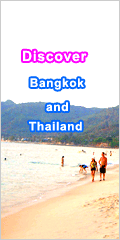A very standard sight on any 'round island tour is the Big Buddha Temple (Wat Phra Yai) on Samui's north coast. The temple is a rather modern construction, and it lacks almost all of the grace and beauty typical of most Thai temples.
The 12 meter high Buddha sits on a small islet connected to the big island by an unpaved causeway. In front of the temple is a cluster of shops and food stalls catering to bus loads of tourists and day-tripping Thais. In amongst the cheap souvenirs is a small silver shop run by the smith who has crafted most of the items on display.
Entering the temple, you first come to a large paved courtyard with a dragon stairway on the other side. Flanking the stairs are two small pavilions housing smaller Buddha images. The stairs lead you up to the platform on which the Buddha image sits. From the platform you get some good views of the long beach where the islet sits.
On a filled area facing the big island are a number of cartoonish mythical statues painted in bright sparkling colors.
The 12 meter high Buddha sits on a small islet connected to the big island by an unpaved causeway. In front of the temple is a cluster of shops and food stalls catering to bus loads of tourists and day-tripping Thais. In amongst the cheap souvenirs is a small silver shop run by the smith who has crafted most of the items on display.
Entering the temple, you first come to a large paved courtyard with a dragon stairway on the other side. Flanking the stairs are two small pavilions housing smaller Buddha images. The stairs lead you up to the platform on which the Buddha image sits. From the platform you get some good views of the long beach where the islet sits.
On a filled area facing the big island are a number of cartoonish mythical statues painted in bright sparkling colors.












